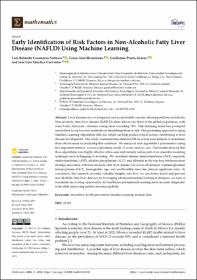Mostrar el registro sencillo del ítem
Early Identification of Risk Factors in Non-Alcoholic Fatty Liver Disease (NAFLD) Using Machine Learning
| dc.contributor.author | Guarneros-Nolasco, Luis Rolando | |
| dc.contributor.author | Alor-Hernández, Giner | |
| dc.contributor.author | Prieto-Avalos, Guillermo | |
| dc.contributor.author | Sánchez-Cervantes, José Luis | |
| dc.date.accessioned | 2023-08-13T01:41:33Z | |
| dc.date.available | 2023-08-13T01:41:33Z | |
| dc.date.issued | 2023-07-07 | |
| dc.identifier.issn | 2227-7390 | |
| dc.identifier.other | https:// doi.org/10.3390/math11133026 | |
| dc.identifier.uri | http://repositorios.orizaba.tecnm.mx:8080/xmlui/handle/123456789/758 | |
| dc.description | Liver diseases are a widespread and severe health concern, affecting millions worldwide. Non-alcoholic fatty liver disease (NAFLD) alone affects one-third of the global population, with some Latin American countries seeing rates exceeding 50%. This alarming trend has prompted researchers to explore new methods for identifying those at risk. One promising approach is using Machine Learning Algorithms (MLAs), which can help predict critical factors contributing to liver disease development. Our study examined nine different MLAs across four datasets to determine their effectiveness in predicting this condition. We analyzed each algorithm’s performance using five important metrics: accuracy, precision, recall, f1-score, and roc_auc. Our results showed that these algorithms were highly effective when used individually and as part of an ensemble modeling technique such as bagging or boosting. We identified alanine aminotransferase (ALT), aspartate aminotransferase (AST), alkaline phosphatase (ALP), and albumin as the top four attributes most strongly associated with non-alcoholic fatty liver disease risk across all datasets. Gamma-glutamyl transpeptidase (GGT), hemoglobin, age, and prothrombin time also played significant roles. In conclusion, this research provides valuable insights into how we can better detect and prevent non-alcoholic fatty liver diseases by leveraging advanced machine learning techniques. As such, it represents an exciting opportunity for healthcare professionals seeking more accurate diagnostic tools while improving patient outcomes globally. | es |
| dc.description.abstract | Liver diseases are a widespread and severe health concern, affecting millions worldwide. Non-alcoholic fatty liver disease (NAFLD) alone affects one-third of the global population, with some Latin American countries seeing rates exceeding 50%. This alarming trend has prompted researchers to explore new methods for identifying those at risk. One promising approach is using Machine Learning Algorithms (MLAs), which can help predict critical factors contributing to liver disease development. Our study examined nine different MLAs across four datasets to determine their effectiveness in predicting this condition. We analyzed each algorithm’s performance using five important metrics: accuracy, precision, recall, f1-score, and roc_auc. Our results showed that these algorithms were highly effective when used individually and as part of an ensemble modeling technique such as bagging or boosting. We identified alanine aminotransferase (ALT), aspartate aminotransferase (AST), alkaline phosphatase (ALP), and albumin as the top four attributes most strongly associated with non-alcoholic fatty liver disease risk across all datasets. Gamma-glutamyl transpeptidase (GGT), hemoglobin, age, and prothrombin time also played significant roles. In conclusion, this research provides valuable insights into how we can better detect and prevent non-alcoholic fatty liver diseases by leveraging advanced machine learning techniques. As such, it represents an exciting opportunity for healthcare professionals seeking more accurate diagnostic tools while improving patient outcomes globally. | es |
| dc.description.sponsorship | TECNM; CONACYT | es |
| dc.language.iso | en_US | es |
| dc.publisher | MDPI | es |
| dc.relation.ispartofseries | Mathematics; | |
| dc.subject | ensembles | es |
| dc.subject | health prevention | es |
| dc.subject | machine learning | es |
| dc.title | Early Identification of Risk Factors in Non-Alcoholic Fatty Liver Disease (NAFLD) Using Machine Learning | es |
| dc.type | Article | es |
Ficheros en el ítem
Este ítem aparece en la(s) siguiente(s) colección(ones)
-
Artículos (DCI) [72]



